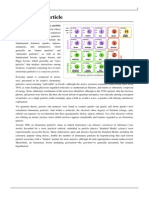An Introduction To Cosmology: Jayant V.Narlikar
Uploaded by
lallu24An Introduction To Cosmology: Jayant V.Narlikar
Uploaded by
lallu24An introduction to Cosmology
Jayant V.Narlikar
Cosmology is the study of the universe; and the universe by definition contains everything. Although, because of its profound implications, cosmology has traditionally excited the imaginations of poet, philosophers and religious thinkers.
But cosmology is mainly concerned with the extragalactic world. It is a study of the large scale structure of the universe extending to distances of billions of light years a study of the overall dynamical and physical behaviour of billions of galaxies spread across the vast distances and of the evolution f this enormous system over several billions of years.
Following units of length, mass, and time that are common in cosmology.
Length light year 9.4x1017 ~1018, while astronomers prefer
parsec, a unit that naturally arises when one is determining stellar distances using the method of parallax. one parsec is defined as the distance at which it is looks at symmetrically from normal direction. Larger units constructed from th parsec (pc) are , kiloparsec (1kpc=103) ,the megaparsec(1Mpc=106 ) and the gigaparsec (1 Gpc=109pc) Time the basic unit of is of course the second but on occasions cosmology demands much longer time scales. The typical unit of time is the gigayear(1 Gyr =109 years+=3x106 s)
Mass the physicist may use the kilogramme or gramme but masses of astronomical objects are best expressed in the mass unit of the Suns mass M=2x1033g.
You might also like
- Hourglass Workout Program by Luisagiuliet 276% (21)Hourglass Workout Program by Luisagiuliet 251 pages
- The Hold Me Tight Workbook - Dr. Sue Johnson100% (16)The Hold Me Tight Workbook - Dr. Sue Johnson187 pages
- Read People Like A Book by Patrick King-Edited62% (66)Read People Like A Book by Patrick King-Edited12 pages
- Livingood, Blake - Livingood Daily Your 21-Day Guide To Experience Real Health77% (13)Livingood, Blake - Livingood Daily Your 21-Day Guide To Experience Real Health260 pages
- COSMIC CONSCIOUSNESS OF HUMANITY - PROBLEMS OF NEW COSMOGONY (V.P.Kaznacheev,. Л. V. Trofimov.)94% (212)COSMIC CONSCIOUSNESS OF HUMANITY - PROBLEMS OF NEW COSMOGONY (V.P.Kaznacheev,. Л. V. Trofimov.)212 pages
- Donald Trump & Jeffrey Epstein Rape Lawsuit and Affidavits83% (1016)Donald Trump & Jeffrey Epstein Rape Lawsuit and Affidavits13 pages
- The 36 Questions That Lead To Love - The New York Times94% (34)The 36 Questions That Lead To Love - The New York Times3 pages
- The 36 Questions That Lead To Love - The New York Times95% (21)The 36 Questions That Lead To Love - The New York Times3 pages
- Jeffrey Epstein39s Little Black Book Unredacted PDF75% (12)Jeffrey Epstein39s Little Black Book Unredacted PDF95 pages
- The 4 Hour Workweek, Expanded and Updated by Timothy Ferriss - Excerpt23% (954)The 4 Hour Workweek, Expanded and Updated by Timothy Ferriss - Excerpt38 pages
- Engineering Physics Lab 1st-Year (Diploma)No ratings yetEngineering Physics Lab 1st-Year (Diploma)62 pages
- 000 - MSC Physics-Curriculum 21.06.2016No ratings yet000 - MSC Physics-Curriculum 21.06.201647 pages
- 14a Plancks Constant Photo Electric EffectNo ratings yet14a Plancks Constant Photo Electric Effect7 pages
- 07.09..2020 - Intrinsic Carrier Concentration100% (1)07.09..2020 - Intrinsic Carrier Concentration14 pages
- Resolving Power of Telescope by MR - Charis50% (4)Resolving Power of Telescope by MR - Charis3 pages
- X-Ray Diffraction and The Bragg EquationNo ratings yetX-Ray Diffraction and The Bragg Equation3 pages
- (Ebook) Science and Mathematics: From Primitive to Modern Times by Narlikar, Jayant V. ISBN 9780367640057, 9781000433197, 9781003203100, 9781000433241, 0367640058, 1000433196, 1003203108, 1000433242 - Own the ebook now with all fully detailed content100% (3)(Ebook) Science and Mathematics: From Primitive to Modern Times by Narlikar, Jayant V. ISBN 9780367640057, 9781000433197, 9781003203100, 9781000433241, 0367640058, 1000433196, 1003203108, 1000433242 - Own the ebook now with all fully detailed content76 pages
- 2-Basic Concepts of Nuclear Physics and Overview of ReactorNo ratings yet2-Basic Concepts of Nuclear Physics and Overview of Reactor67 pages
- 7.GATE - Atomic and Molecular Physics Solution-2023No ratings yet7.GATE - Atomic and Molecular Physics Solution-20235 pages
- Introduction To Plasma Physics and Controlled Fusion Notes For Journal 1100% (1)Introduction To Plasma Physics and Controlled Fusion Notes For Journal 118 pages
- Kater's Pendulum: Scientific Aims and ObjectivesNo ratings yetKater's Pendulum: Scientific Aims and Objectives7 pages
- Purple Hat App: Multiple Choice QuestionsNo ratings yetPurple Hat App: Multiple Choice Questions106 pages
- Problems On Plane Waves, Poynting Vector, and ElectromagnetismNo ratings yetProblems On Plane Waves, Poynting Vector, and Electromagnetism2 pages
- Lecture Notes - Carrier Transport Phenomena - 2No ratings yetLecture Notes - Carrier Transport Phenomena - 218 pages
- Atomic Physics 2.photoelectric Effect Points To Remember100% (1)Atomic Physics 2.photoelectric Effect Points To Remember10 pages
- Btech 1 Sem Engineering Physics Kas101t 2022No ratings yetBtech 1 Sem Engineering Physics Kas101t 20222 pages
- Set1 - Figure of Merit of A GalvanometerNo ratings yetSet1 - Figure of Merit of A Galvanometer5 pages
- Btech 2 Sem Engineering Physics Kas201t 2022No ratings yetBtech 2 Sem Engineering Physics Kas201t 20222 pages
- Important 2 and 3 Mark Questions and Answers100% (4)Important 2 and 3 Mark Questions and Answers23 pages
- Preview Hindimasterjee - Basic Grammar HandbookNo ratings yetPreview Hindimasterjee - Basic Grammar Handbook32 pages
































































































